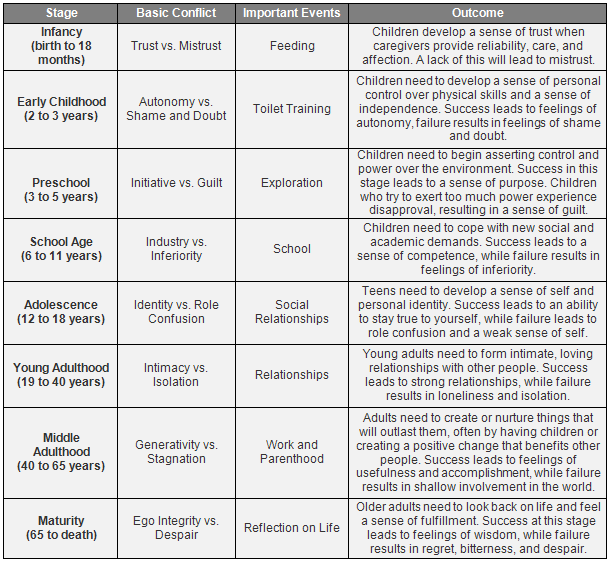Children and Emotional Development
A child’s earliest experiences with emotion most often occurs in the family setting. Consequently, the family plays an important role in the development of emotional understanding, particularly interactions between parents and children. For example, children who possess secure attachments with their parents show greater emotional understanding than those children who do not possess secure attachments (Laible & Thompson, 1998).
Denham, Zoller, and Couchoud (1994) examined family relationships and the discourse they hold around emotions. It was found that maternal emotional discourse is especially salient in a child’s development of emotional understanding. Specifically, mothers who explain their emotions to their children help to promote proficiency in their child’s emotional understanding. Furthermore, children who are exposed to negative maternal emotions, such as anger, appear to be at a disadvantage in understanding the emotions of others and their own.
Peers also have a significant influence on the child’s emotional development. As children interact with their peers, they create peer cultures in which to carry out the complex processes of making friends, gaining access to play groups, and facilitating shared action (Cosaro & Eder, 1990). Because of the intimate nature of friendship, emotional competence is attained in the context of peers sharing their emotions with each another (Denham et al., 1994). Dunn and Cutting (1999) also found that four-year-olds who showed emotional understanding had a more positive interaction with their friends, including cooperative shared pretend play, low frequency of conflict, and successful communication when compared to those who did not exhibit emotional understanding.
Other studies confirm that friends who engage and share in conversation about emotion they experienced more cooperative interactions with each other (Brown, Donelan-McCall, & Dunn, 1996). Conversely, children who miss important emotional messages or misinterpret them are at a disadvantage in social situations. This leads to disrupted social interactions, negative social relationships, and possibly inappropriate behaviour (Holder & Kirkpatrick, 1991).
Child rearing styles also contribute to the development of emotions in children. For example, a child of authoritarian parents (i.e. a parenting style that tends to make most of the decisions for the child and can appear cold and rejecting tend to be more anxious, unhappy with low self esteem and tend to react with hostility when they are frustrated (Berk, 2007).
Conversely, an authoritative parenting style (i.e. a parenting style that tends to be warm, attentive and sensitive to the child’s needs) is more likely to encourage happier children with high self esteem. Permissive parenting adopts a warm and accepting style yet uninvolved. Such parents will tend to engage in very little control over their child’s behaviour. As a consequence, the child of such an approach will tend to be impulsive, disobedient and often rebellious (Berk, 2007).
Erickson described a psychosocial process of development across the lifespan that examined the interplay between intrapersonal needs and interpersonal relationships and the key emotional responses this interplay might typically evoke within the person at key milestones of development throughout their life. For example, an infant’s relationship with their primary caregiver will influence their level of trust in others and the world. The more established this sense of trust becomes the more hopeful a person will feel throughout their life.
Another example can be seen in a preschooler who may be discouraged to take initiatives in tasks and activities whereby they are made to feel guilty for trying things out but getting it wrong or making mistakes. Such feelings of guilt, as opposed to feeling a sense of motivation and pride in giving things a go, could inhibit the child from taking initiative throughout their life.
The examples of Erikson’s theory of psychosocial development above offer an overview of how long term emotional dispositions can develop and impact the individual throughout their entire life through important psychosocial interactions. Table 1 below offers further detail of Erikson’s stages of psychosocial development and the emotions considered to be developed as a consequence of the interactions contained within it.
Table 1. Erickson’s Psychosocial Developmental Stages

References
- Berk, L. (2007). Development through the lifespan (4th ed.). Boston, MA: Pearson.
- Brown, J. R., Donelan-McCall, N., & Dunn, J. (1996). Why talk about mental states? The significance of children’s conversation with friends, siblings, and mothers. Child Development, 67, 836-859.
- Cosaro, W., & Eder, D. (1990). Children’s peer cultures. Annual Review of Sociology, 16,197-220.
- Denham, S. (1998). Emotional development in young children. New York: Guilford Press.
- Holder, H. B., & Kirkpatrick, S. W. (1991). Interpretations of emotion from facial expressions in children with and without learning disabilities. Journal of Learning Disabilities, 28, 170-177.
- Laible, D. J., & Thompson, R. A. (1998). Attachment and emotional understanding in preschool children. Developmental Psychology, 34, 108-1045.

